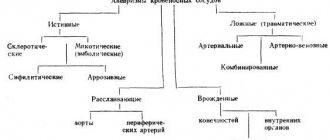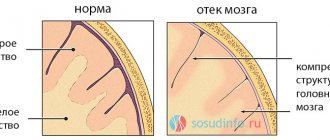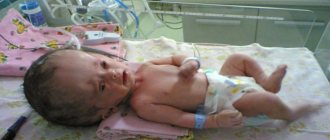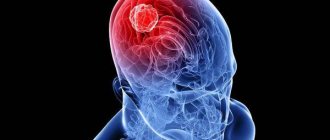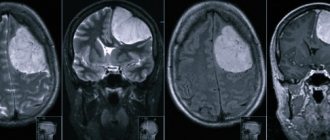Brain contusion, or concussion, is a serious post-traumatic disorder that manifests itself as a failure of the functional abilities of the central nervous system. There are several types of such disorders, which have a number of characteristic features depending on the conditions during which the injury occurred.
Development mechanism
There is a specific mechanism for the development of brain contusions:
- movement of the hemispheres . The medulla oblongata, midbrain, and brainstem are the brain stem. It does not change its position between the impact and counter-impact zones, while the hemispheres shift, which leads to damage. During an impact, the brain stem does not receive impulses from the cerebral cortex, this causes loss of consciousness. The time spent unconscious depends on the force of the blow;
- offset . During an injury, the brain is displaced in the skull. In the place where the blow occurred, pressure increases and damage to brain structures occurs (minor hemorrhages and damage to nerve cells). In the impact zone, the pressure decreases, and small cavities filled with liquid form in the intercellular substance and nerve cells. If the impact was very strong, the low pressure quickly gives way to high pressure, causing them to burst, resulting in the formation of large areas of damage. As a result of such injuries, large areas of the brain are affected;
- hypodynamic effect . The ventricles of the brain are filled with cerebrospinal fluid, which, as a result of the impact, begins to move quickly in a certain direction. As a result, pinpoint hemorrhages are formed. They almost always occur, regardless of the area in which the blow was made.
Typology of bruises
There are several types of bruises and they are classified according to severity:
- Light form.
- Average.
- Severe degree.
A mild form of concussion is identified as a concussion. With this injury, the most positive dynamics of recovery and prognosis for the victim are observed. Symptoms of mild contusion:
- loss of consciousness for a period of 30–60 minutes;
- slow reaction, drowsiness;
- short-term memory loss;
- pain syndrome;
- sensation of tinnitus;
- nausea, vomiting;
- vertigo;
- arrhythmia or tachycardia;
- visual impairment;
- pulling sensation in the occipital muscles.
Symptoms after a concussion can last from 7 to 25 days, the functions of the nervous system are gradually restored. In cases where symptoms suggest the development of anomalies, the patient is prescribed a CT scan.
A brain contusion of moderate severity is diagnosed when there are cracks or fractures of bone tissue, and the formation of zones of subarachnoid blood effusions; the victim may also experience the following disorders:
- prolonged loss of consciousness up to 4 hours;
- amnesia with subsequent memory recovery;
- migraine;
- vertigo;
- nausea, repeated vomiting;
- tachycardia;
- hypertension;
- fever;
- paresthesia;
- visual impairment;
- epileptic seizures;
- convulsions.
With this form of bruise, it is possible that irreversible changes in organ tissues may occur; as a rule, the symptoms are associated with neurological disorders within two months after the injury occurs.
Severe contusions require a long recovery, and the process may not be final. The statistics are not reassuring and indicate that more than 30% of severe head injuries result in the death of the victim.
Symptoms of this phenomenon:
- long-term loss of consciousness, possible coma (from 4 hours to a month);
- convulsions;
- difficulty breathing;
- hypertension;
- violation of thermoregulation;
- visual impairment;
- weak reaction to light;
- spasms throughout the body;
- paralysis;
- numbness of the extremities (loss of sensation in the arms or legs);
- confusion of speech.
With adequate first aid and further rehabilitation therapy, it is possible to reverse some pathological processes that develop in the structures of the brain and affect the functioning of other organs. It takes from six months to several years for patients to recover from severe head injuries. Most often, such damage affects mental consciousness or the functions of the musculoskeletal system, which ultimately leads to disability.
Causes
In the vast majority of cases, the cause of a head injury is a traumatic brain injury. The main concomitant factor influencing the frequency of its occurrence is alcohol intoxication. Approximately 20% of victims with diagnosed bruises drank alcohol.
One of the common causes of bruises is playing hazardous sports.
Causes of traumatic brain injuries:
| Causes | Description |
| Road traffic injuries | The victim may be a pedestrian, driver or passenger. Most often, such injuries prevail in the autumn-winter period, when weather conditions worsen significantly. |
| Domestic injuries | In this case, the patient receives a mechanical injury at home or in the yard, outside of production conditions. Most often - due to careless performance of any duties during cleaning or repairs. Also, household injuries occur when falling from a height of one’s own height onto various objects. |
| Criminal injuries | Often bruises occur as a result of blows to the head with a blunt object (bat, stone, stick or brass knuckles). This type of injury also occurs if the victim is punched and his head falls on a hard object or the ground. |
| Child injury | Since in children of the first year of life the head is the heaviest part of the body, falling even from a small height can cause a bruise. Often injuries received before two years have delayed consequences |
| Sports injuries | Risky sports include martial arts, boxing, ski jumping, cycling, etc. Both beginners and professional athletes are at risk of getting a traumatic brain injury during exercise. |
| Industrial injuries | An injury may occur during work as a result of non-compliance with safety precautions. |
| Injuries sustained during epileptic seizures | During an epileptic attack, a person may fall to the ground or a hard object from their own height |
Symptoms of concussion
The international classification ICD 10 classifies brain contusion as an intracranial injury and is classified depending on the type of brain injury under the code S06.3 “Focal brain injury” or S06.2 “Diffuse brain injury.”
As mentioned earlier, each degree of contusion in a victim is characterized by the appearance of certain symptoms of disruption of the central nervous system, caused by the appearance of several foci of destruction of brain matter.
Some of the most common consequences of this type of injury include:
- Light degree:
- short-term loss of consciousness (up to 10 minutes); prolonged headache;
- dizziness;
- nausea, vomiting;
- noise in ears;
- increased heart rate, respiration, blood pressure;
- clouding of consciousness;
- muscle hypertonicity;
- “veil before the eyes”;
- decreased performance of the sense of touch.
- Average degree:
- loss of consciousness for a long period of time (10 minutes or more);
- retrograde amnesia;
- severe headaches;
- nose and ear bleeding;
- dizziness;
- changes in consciousness, up to the development of psychosis;
- vomit;
- increased blood pressure, heavy breathing, increased heart rate.
- Severe degree:
- coma or prolonged loss of consciousness for a period of time up to 3 weeks;
- disruption of life support systems due to damage to the structures of the reticular formation;
- mental disorders;
- paralysis;
- severe tachycardia;
- epileptic seizures;
- hemorrhages in the brain and subarachnoid space.
Often, even after receiving a mild concussion, the victim can change his behavioral habits, and his character changes not for the better, which is noticeable to others.
Therefore, to prevent the development of complications, such patients should remain under the supervision of specialists.
Symptoms of brain contusion
Minor bruise
The most common is a mild bruise that does not pose a threat to the patient’s life. The patient has the following symptoms:
- loss of consciousness . The probability of developing this symptom is almost 100%. As a result of injury, the cerebral cortex for some time stops sending impulses to its trunk, where the structure responsible for maintaining consciousness is located. With a mild form of bruise, the victim may be unconscious for 2 minutes to an hour;
- lethargy . The patient becomes drowsy and weak. A person may have poor orientation in time and space, allowing for some inaccuracies;
- amnesia . As a result of pathological disorders, the patient experiences memory loss. Amnesia can be retrograde (the person forgets events that preceded the traumatic brain injury), anterograde (the patient stops remembering after the injury), or mixed. Traumatic amnesia is temporary and memory usually returns after tissue repair;
- headache . Initially, it occurs due to a violation of the outflow of cerebrospinal fluid and increased intracranial pressure. In the future, the cause of cephalgia becomes swelling and inflammation in places where brain structures are damaged. With a mild form of bruise, the headache can be observed for 2-3 days, then it gradually recedes;
- vomit . The vomiting center is located in the brain stem. Transient disorders cause vomiting, which does not bring relief because it does not depend on the state of the gastrointestinal tract. In uncomplicated cases, vomiting usually occurs once, it appears suddenly, with no nausea;
- dizziness . It occurs as a result of a blow to the back of the head, when the cerebellum, which is responsible for the ability to maintain body position, is injured. Also, this area may be damaged as a result of a counter-impact if the frontal area is damaged. It is necessary to distinguish a faint state from dizziness (in this case the patient does not have a decrease in blood pressure, darkening of the eyes and weakness in the legs);
- breathing disorder . Transient disorders affecting the respiratory center located in the brain stem lead to the fact that after an injury a person’s breathing becomes more frequent. In mild cases, they can be observed for 2–3 days and then disappear;
- heart rhythm disturbances . They are the result of disorders of the autonomic nervous system. Quite often, after injury, the patient's heart rate increases or decreases and blood pressure increases;
- nystagmus (involuntary movements of the eyeballs). The reason for this is damage to the nerve structures responsible for eye movement. Also, with brain contusions, the victim may have different pupil sizes in the right and left eyes;
- increased tone of the neck muscles . The reason for this is damage to the arachnoid and pia mater of the brain. As a result, the victim experiences a symptom similar to meningitis. With Kernig's syndrome, if you bend your leg at the knee and bring it towards you, you will not be able to fully straighten the knee joint. This symptom can be observed for three weeks, then it disappears;
- Brudzinski's sign . If the chin is pressed to the chest, the knee joint reflexively bends. This symptom is also considered a sign of damage to the nervous system. It disappears on its own after 2–3 weeks.
Types of damage
Jean-Louis Petit (a French scientist in the field of surgery and anatomy) in 1774 described 3 forms of brain and skull injury - concussion, compression and bruise. Subsequently, they were used as the basis for a new classification of traumatic brain injury (TBI). Today, experts identify the following forms of damage:
- concussion;
- compression of the head and/or brain;
- diffuse axonal brain damage;
- bruises of the lobes of the brain, trunk of varying degrees of severity (severe, moderate and mild).
Injuries to the skull and brain are often caused by reasons unrelated to health (for example, getting into an accident), but sometimes the damage turns out to be secondary, that is, caused by a violation of consciousness, balance, or orientation. This happens in many somatic and cerebral disorders (for example, stroke, sudden dizziness).
Shake
This brain damage is a functionally reversible form. The patient loses consciousness for a period calculated in seconds or minutes. Short-term amnesia may occur. After a concussion, the patient experiences vomiting, pain when moving the eyeballs, ringing in the ears, and general weakness.
Squeezing
Head compression is an injury that occurs due to mechanical stress. The biomechanics of injury consists of impact and compression. Compression is diagnosed in people who have become victims of explosions, earthquakes, and mine collapses.
With this type of head injury, swelling is observed, which appears after the victim is released and gradually reaches its apogee on 2–3 days. Further, extensive tissue necrosis may occur. Due to these processes, intoxication of the body begins. Observed symptoms: severe weakness, high fever, nausea, repeated vomiting, dyspeptic symptoms. The severity of swelling and intoxication depends on the time of compression:
- From 30 minutes to 5 hours. The patient experiences moderate swelling of the soft tissues of the head. Intoxication is minor.
- From 2 hours to 2 days. This time of compression is characterized by severe swelling of the soft tissues of the head, subsequent moderate trophic disorders, and intoxication syndrome.
- From 1 to 2.5 days. The patient experiences severe total swelling of the head followed by tissue necrosis. Intoxication in such cases is severe.
In severe skull trauma, the brain may be compressed. This damage is caused by fractures (in cases where bones are pressed into the brain), intracranial hematomas, swelling and other causes that occur after impacts. Possible symptoms:
- a disorder of the nervous system, accompanied by increased mental and motor activity;
- increasing pain in the head;
- repeated vomiting;
- disturbance of consciousness;
- epilepsy attacks;
- increased blood pressure.
Diffuse axonal injury
This is the most severe type of brain injury. It is diagnosed most often in children and young people. The main causes of injury are getting into an accident, falling from a height. In such situations, the axons (the long processes of nerve cells) become stretched and torn. Some people die some time after being injured, others fall into a long coma.
A feature characteristic of damage is the exit from a comatose state and the beginning of vegetative life. A person can live for several days, or for several months or years.
In general, the outcome of the injury depends on the degree and extent of axonal defects, secondary pathological changes in the victim’s body (impaired brain metabolism, edema), and extracranial complications. Adequate therapy and well-thought-out rehabilitation play an important role. With the right approach to treatment and recovery, there is a possibility of regression of neurological disorders, partial or complete restoration of mental functions.
Severe injury
Brain contusion is an injury characterized by macroscopically detectable areas of damage to the brain matter. In severe cases, victims lose consciousness for several hours or even several weeks. Rough focal hemispheric or brainstem symptoms are observed. Often, when examined, people are diagnosed with fractures of the vault and base of the skull.
When the brain is severely damaged, vital processes in the body are disrupted. This poses a risk of death.
Moderate severity of injury
With a moderate injury, the patient loses consciousness. A person can remain in this state for several minutes or several hours (about 4–6). When the victim comes to his senses, he experiences a number of symptoms:
- headache;
- memory loss;
- nausea;
- recurrent vomiting;
- impairment of the body's ability to respond to various stimuli;
- speech disorders;
- disruption of normal eyeball mobility;
- inequality of pupil sizes;
- paralysis of limbs, etc.
Mild injury
A mild bruise is a brain injury that is characterized by a favorable course. Its clinical manifestations are reversible. People usually recover from such an injury within 3 weeks.
With a slight bruise, the victim may also lose consciousness, but the stay in this state is short-lived - a few minutes (maximum hour). In the future, typical symptoms arise - post-traumatic memory loss, headache, dizziness, nausea, vomiting (in some cases it may be repeated). A mild traumatic brain injury does not disrupt the vital functions of the human body.
First aid
First of all, when you find a patient with a traumatic brain injury, you must call an ambulance. Before her arrival, it is necessary to ensure that the person’s airway is open and ensure that the vomit comes out and the tongue does not roll back.
If you suspect a brain contusion, before the ambulance arrives, the victim must be placed on his side and ensure a stable body position
For this purpose, the unconscious patient must be placed on his side and ensure a stable position. I bend the lower arm at the elbow joint, and place the upper arm (in relation to the patient’s body) under the head. Also, the lower leg is straightened, the upper leg is bent at the knee.
If vomiting occurs, the oral cavity must be cleaned with fingers wrapped in a cloth. If a person is conscious, he should not rise to his feet, he should lie on his side or back.
Basic concepts and clinical picture
Most people do not distinguish between the concepts: concussion, bruise and compression of the brain. One thing they have in common is head damage to varying degrees.
a - injury with a sharp object b - injury with a blunt object c - impact with an obstacle
A concussion differs from a brain contusion:
- A pronounced degree of severity of the pathological process - a concussion is, in fact, a bruise of mild severity.
- Symptoms - the wound is externally closed, there may be a slight loss of consciousness or memory, a slower pulse or a drop in blood pressure. Manifestations of a bruise are much more dangerous.
- Treatment methodology - in many cases, it is prescribed only in compliance with a gentle regimen, and a mandatory X-ray of the head; injections of painkillers and anti-edematous medications are possible.
- In addition, a concussion differs from a brain contusion in possible complications. From a concussion, they are observed in rare cases and are characterized by a mild course (recurrent migraines, dizziness, sleep disturbances, changes in blood pressure, visual impairment).
- Another difference is the following: different diagnostic procedures are used to determine a concussion or brain injury. To confirm a mild brain injury, it is enough to examine and listen to the patient’s complaints. X-rays may be required to confirm the diagnosis.
Compression of the brain is considered one of the most severe types of head injuries, in which swelling and hematomas form in the tissues. It is accompanied by severe symptoms in the form of severe headaches, vomiting, convulsions and even paralysis.
So, we have figured out what the differences are in the concepts of a concussion and a bruise, then we will try to figure out what the main causes of such phenomena are, how to distinguish them, how to treat them, and also what complications are fraught with frequent concussions and bruises.
Diagnostics
Diagnosis is carried out by assessing the patient’s general condition, neurological disorders and the condition of internal organs.
To clarify the diagnosis, computed tomography is performed
In the diagnosis of focal lesions, the following must be determined:
- side : right, left, bilateral;
- lobar localization : temporal, frontal, parietal, occipital lobes, cerebellum, etc.;
- relation to the surface of the hemispheres : basal, sagittal, convexital, parasagittal.
The severity of the injury is determined by cerebral, brainstem and focal symptoms. A CT scan is performed to assess the extent of brain damage and determine how to treat it.
Treatment in hospital
Treatment tactics depend on the characteristics of the TBI. For mild injuries, the components of therapy are rest, bed rest, taking medications to eliminate headaches, dizziness and other symptoms. For moderate injuries, the above measures are supplemented with the use of drugs that improve cerebral blood flow. If the integrity of the skin is damaged, antibacterial therapy is advisable. In case of severe injuries, treatment is associated with solving such problems as eliminating respiratory disorders, stabilizing hemodynamics, combating cerebral edema, and hypoxia.
In some cases, patients require surgical treatment. Indications for emergency surgery:
- various intracranial hematomas;
- pneumocephalus, which causes compression of the brain;
- depressed fractures;
- gunshot wounds, etc.
Treatment of brain contusions
Depending on the severity of the brain contusion, treatment can be carried out conservatively or surgically.
Surgical treatment
Surgery is performed in approximately 20% of cases if, as a result of swelling, the brain is compressed or the position of brain structures changes.
Traumatic edema leads to a significant increase in intracranial pressure, which is not regulated with medications, and neurological symptoms increase. This is an indication for urgent surgery.
The patient is also operated on if his internal organs have increased dysfunction or the area of crushed brain tissue is too extensive. Hematomas larger than 4 cm in diameter are surgically removed.
In order to gain access to brain tissue, the neurosurgeon performs a craniotomy (making holes in the bone).
Conservative therapy
Conservative therapy is carried out to eliminate secondary brain damage. They are a consequence of injury and significantly increase the risk of death, and also lead to damage to tissues and blood vessels. Conservative treatment uses respiratory therapy. If breathing is impaired and the level of oxygen in the patient’s blood decreases, a machine for artificial ventilation of the lungs is used.
Ceraxon is used to reduce the impact of secondary damage
In order to reduce the consequences of a bruise, drugs are used that restore the volume of lost blood, saturate with oxygen and restore the water-salt balance.
When intracranial pressure increases above 21 mm Hg. Art. An intraventricular catheter is used to drain cerebrospinal fluid. A solution of mannitol is administered intravenously, which reduces intracranial pressure.
If there is no expected effect from these manipulations, the patient is placed in an artificial coma. In this condition, the cerebral cortex is less susceptible to damage.
In order to reduce the impact of secondary damage on nerve cells, neuroprotectors are used: Erythropoietin, Ceraxon, Neuroxon, Gliaton. They begin to be administered immediately after the patient is admitted to the hospital. These medications help restore the white and gray matter of the brain.
Treatment
Brain contusion is a serious condition that should not be tried to be treated at home, so the victim requires prompt hospitalization to a medical facility, where he will be monitored by neurologists, neurosurgeons and, subsequently, rehabilitation specialists.
Depending on the degree of injury, treatment of a brain contusion can be carried out using conservative medications and surgery. Thus, with a mild injury to the soft tissues of the head, the victim is prescribed a number of drugs that have an anti-edematous effect, as well as neurotopic and cerebrovascular agents. In some cases, the use of painkillers and anti-inflammatory and antiemetic drugs is allowed.
In case of serious traumatic brain injury, it is possible to use surgical treatment methods, during which extensive hematomas or foreign bodies trapped there will be removed from the brain tissue. In some cases, such therapy is used for the accumulation of cerebrospinal fluid in the ventricles and disruption of its outflow in other structures of the central nervous system.
Consequences of a brain injury
Tissue damage can cause the development of serious pathologies. Severe traumatic brain injuries can lead not only to disability, but also to death.
All consequences of such injury are divided into three clinical forms:
| Form | Description |
| Liquorodynamic | As a result of impaired absorption and circulation of cerebrospinal fluid, the patient may experience hydrocephalus (accumulation of cerebrospinal fluid), porencephaly (formation of channels between the brain structures and the ventricular cavity), cerebrospinal fluid cysts or pneumocephalus. Typically, such complications are accompanied by increased intracranial pressure, epileptic seizures, decreased mental abilities and memory disorders |
| Vascular | Injury to blood vessels often leads to the appearance of intracranial hematomas, hemorrhages and aneurysms. As a result, a person experiences convulsive seizures, paresis, severe headaches, psychosis, speech disorders |
| Fabric | The consequence of injury is tissue damage to the white or gray matter, which can lead to post-traumatic brain atrophy, hardening due to the proliferation of connective tissue, or inflammation of the dura mater. In some cases, patients have skull defects. Such pathologies often lead to the development of psychopathy, facial nerve paresis, blindness, and epileptic seizures. |
In mild forms of brain contusion, the prognosis is often favorable. In this case, the patient does not experience severe consequences.
In order to prevent the development of pathologies after any, even minor, traumatic brain injury, it is necessary to consult a doctor.
Consequences
The damage to health caused by a brain contusion cannot be immediately determined, since most neurological complications due to the destruction of brain structures come with time, and their severity depends on the degree of injury suffered.
Common consequences of moderate to severe brain contusion:
- prolonged loss of consciousness (most often a complication of a stroke);
- inflammatory processes in the focus of crushed brain tissue develop in the first day after injury;
- pneumonia;
- heart disease;
- epilepsy;
- metabolic disorder;
- encephalopathy;
- acute ataxia, looks like fainting without loss of consciousness, during which there is a sharp relaxation of all the muscles of the body;
- decreased visual and hearing acuity;
- speech and intellectual disorders;
- fast fatiguability;
- nervousness, irritability.
From the autonomic nervous system:
- fainting;
- violations of body thermoregulation;
- hypertension or hypotension.
Also, the manifestation of the consequences depends on the location of the damaged area and the speed of medical care. For example, an untreated bruise of the occipital part of the head entails the following consequences and complications:
- disturbances in the functioning of the visual organs, most often developing unilateral agnosia or unresponsiveness to incoming visual information from mechanical influence;
- frequent mood changes;
- dizziness, pain in the back of the head, subsequent swelling and damage to brain tissue;
- vulnerability to depression;
- the appearance of hallucinations and confusion.
The most serious health problems are observed in children who have suffered a brain contusion in infancy - very often such an injury leads to the death of a small patient or severe disability in the future, since during this period the formation and maturation of the central nervous system occurs.
At the same time, moderate brain contusion in young patients manifests itself even after rehabilitation and a long recovery period - they experience speech impairment, mental disorders, and a decrease in mental abilities.
How to determine a concussion? Diagnostics
Despite the clinical picture of a concussion, which allows it to be distinguished from other types of traumatic brain injury, the patient must undergo a number of examinations. Diagnosis in this case is aimed at excluding a more severe pathology, since during a concussion, most research methods do not find any changes in the brain and bones of the skull.
The very first and most accessible examination method is radiography of the skull (in other words, craniography) in two projections: direct and lateral. If a fracture of the base of the skull is suspected (cerebrospinal fluid leakage, that is, leakage of cerebrospinal fluid from the ear or nose), other projections are used. A concussion does not show fractures or cracks in the skull bones on x-ray.
Even in the absence of obvious fractures of the skull bones, the victim may develop an intracranial hematoma after some time. Before symptoms of a hematoma appear, the patient often feels well. This period of imaginary well-being is called the “bright period.”
That is why it is necessary to be under the supervision of a specialist for the first few days after the injury, since an intracranial hematoma almost always requires immediate surgical intervention.
From time to time it becomes necessary to perform an X-ray of the cervical spine, at least in a lateral projection, in order to exclude dislocation of the vertebrae or fractures of their processes. This is done in cases of so-called whiplash, which most often occurs in road accidents to the driver or passengers. It is accompanied by stretching of the ligaments and muscles of the neck, and is manifested by pain in the back of the head, along the back of the neck and often severe dizziness.
Performing a CT or MRI for a concussion is not very informative, since it does not reveal any structural changes. These methods are used rather to exclude cerebral contusion or intrathecal hematoma.
This method of diagnosing traumatic brain injuries, such as lumbar puncture, has faded into the background in recent years. Since in the acute period of injury, lumbar puncture is rarely informative, but it carries the risk of developing dislocation of brain stem structures, which can worsen the patient’s general condition and lead to death.
This method involves a puncture in the lumbar region to obtain cerebrospinal fluid from the subarachnoid space and subsequently analyze the composition of this fluid. During a concussion, the composition of the cerebrospinal fluid does not change. Therefore, at present, this diagnostic method is used only when complications such as post-traumatic meningitis are suspected or to exclude subarachnoid hemorrhage due to the lack of available CT or MRI studies of the brain.
It is also necessary to consult an ophthalmologist who will assess the condition of the fundus. Congestion in the fundus may indicate the development of an intracranial hematoma.
Another method often used to confirm the diagnosis of concussion is echoes. Echoencephaloscopy (EchoES) is a one-dimensional ultrasound diagnostic method for studying the brain.
Echoencephaloscopy has no contraindications and does not harm health at all. It is used in both children and adults. Using echoes, you can determine the presence or absence of displacement of the midline structures of the brain, which may be evidence of the development of a hematoma. In cases of concussion, no changes are detected during echoes.
Follow all the doctor’s recommendations, do not refuse the examination, only in this case the diagnosis will be established correctly.
First aid
Concussion of any severity requires emergency medical care.
The victim is given complete rest and prompt hospitalization. Before the ambulance arrives, the person must be placed on his side so that he does not choke on the vomit. The main helper for a shell-shocked person is cold. Place a wet towel or ice packs on your head to reduce pain.
If there is difficulty breathing or irregular pulse, the following actions are recommended::
- caffeine subcutaneously (1 ml solution);
- Cordiamine injection (1 ml intramuscularly or intravenously);
- injection of camphor extract (2-3 ml).
Performing direct cardiac massage through the chest is prohibited, as there is a high risk of subsequent organ injury. If there is no breathing, it is necessary to perform the “Mouth to Mouth” technique of stimulating the lungs. Before doing this, be sure to clear the victim’s mouth and nasal passages of soil or sand. You need to remove dirt from your mouth and throat using a clean finger, scarf or bandage.
Watch a video about first aid for cerebral contusion:
general information
During any head injury, the hemispheres of the brain are displaced. The lower sections are at rest, but impulses from the upper hemispheres reach them. The functioning of the brain structure is disrupted. Reticular formation leads to clouding of a person’s consciousness. Therefore, how long the victim will remain unconscious depends on the strength of the blow received.
Sometimes, when a head injury occurs, the cerebrospinal fluid begins to move. Too active movement becomes a consequence of the appearance of pinpoint hemorrhages. Along with other negative symptoms that occur with a bruise, bruising leads to serious brain damage.
After the blow received, inflammation appears, which provokes the development of edema and swelling in undamaged nearby tissues, as a result of which normal blood supply is disrupted. In some cases, a brain contusion can be combined with other head injuries: skull fracture, hemorrhage, intracranial hematomas.
Such injuries can occur several hours after the injury and within several days, because of this the victim must be provided with medical care and constant medical supervision. The occurrence of such pathologies in the brain entails negative consequences for the patient.
Symptoms of bruise
If we consider the general symptoms, without taking into account the severity of the bruise, then doctors include:
- loss of consciousness and dizziness - depending on the severity, they may manifest themselves infrequently and not so clearly, but in case of serious injuries they are quite severe and have a pronounced character;
- frequent or rare attacks of headache , vomiting and nausea;
- the patient may develop retrograde amnesia and a failure in coordination of movements - an unsteady gait, body movements in one direction or another;
- changes in visual and speech function , problems with hearing and consciousness - these include darkening of the eyes, auditory hallucinations or memory loss, complete or partial;
- the patient’s pupils dilate, there is a problem with the swallowing reflex;
- the pulse decreases, breathing becomes weak and intermittent;
- the patient is diagnosed with hypertension , certain parts of the body lose their sensitivity;
- a person may experience hemorrhages from the ears and nose; in some complex manifestations of the pathology, the patient may experience paralysis and fall into a coma.
What is a cerebral contusion?
The term has Latin roots and literally means “bruise.” This is an injury that is accompanied by the development of foci of destruction (destruction) of the brain. Despite the translation, contusion is significantly different from contusion . In severe cases, it provokes a comatose state, and after regaining consciousness, it is difficult for a person to speak, he has difficulty hearing, and signs of amnesia are also common (not observed with bruises).
With a sharp and strong impact, a damage zone appears that corresponds to the location of the fall. Next, the brain is displaced and again hits the hard cranial bones, thereby forming a second area of bruise. If the focus of the brain contusion is localized in the anterior or central part of the gyri, paralysis appears and loss of sensitivity occurs. When the frontal lobes or temporal part are damaged, speech is impaired. Contusion of the corpus callosum is accompanied by persistent mental disorders in humans.
IMPORTANT : Brain contusion is often accompanied by internal hemorrhage. Its consequences depend on the severity of the damage: from minor changes to disability and death.
Are there different degrees of severity for concussions?
A concussion is a mild traumatic brain injury and has no severity. More precisely, they are not isolated when making a diagnosis. But, let's just say, among doctors there is such a gradation:
- mild concussion – there is no characteristic anterograde amnesia, the patient does not lose consciousness at the time of injury and after it, the inherent cerebral symptoms (headache, drowsiness, nausea) last no more than half an hour;
- with a moderate concussion, general cerebral symptoms and memory impairment occur, but there is no loss of consciousness;
- severe degree is manifested by the presence of most of the symptoms characteristic of a concussion.
Types of bruises
The classification of brain injuries depends on the location : most often, injuries are recorded to the back of the head and temporal lobes, which usually receive blows to the head. Frontal and parietal bruises are much less common.
According to the clinical picture, there are 4 forms of brain injury:
- Extrapyramidal . Damage to the cortex and subcortical formations is expressed in impaired motor activity.
- Diencephalic . Damage to the hypothalamus is accompanied by general hyperthermia, tachypnea (slow breathing), increased blood pressure, as well as various types of hallucinations.
- Mesencephalic . The most pronounced symptom is visual disturbances: involuntary rhythmic movement of the eyeballs (nystagmus), strabismus, significant constriction of the pupil (miosis) or, on the contrary, its dilation (mydriasis).
- Mesencephalic-bulbar . It is characterized by brain damage with suppression of functions: swallowing and speech disorders, low blood pressure, decreased body temperature, bradycardia.
The most common classification of bruises of the brain divides injuries according to the intensity of symptomatic manifestations.
1st degree bruise
At the time of injury, loss of consciousness occurs (from several seconds to 5 minutes). Headache and dizziness, weakness, nausea occur . Blood pressure often rises, temperature rises, and pulse rate changes.
2nd degree bruise
The patient remains unconscious for several hours . Upon regaining consciousness, the victim experiences a severe headache. Repeated vomiting occurs. There is an increase in blood pressure, tachycardia or, conversely, bradycardia. Mental and perception disorders are often present.
When the skull bones are fractured due to TBI, hemorrhage is possible.
3rd degree bruise
Severe trauma during which the victim may fall into a long-term coma . When nerves are damaged, paresis and paralysis of various muscle groups develop, meningeal and brainstem manifestations are pronounced (muscle rigidity, hyperesthesia, nystagmus, etc.). With such lesions, when the heart and respiratory centers of the brain are affected, death is quite likely.
Treatment of concussion
When choosing treatment methods, the degree of tissue damage is taken into account. Treatment is usually conservative and involves taking medications. Additionally, if paresis and paralysis occur, physiotherapy, massage and physical therapy are prescribed. First aid for head bruises and contusions can be provided by eyewitnesses to the incident. What should be done:
- Provide the victim with a state of physical and psychological peace. The patient is placed on his side to prevent vomit from entering the respiratory system.
- Check the free access of oxygen. If necessary, unbutton the top buttons of the shirt and loosen the tie.
- If there is bleeding from an open wound, apply a bandage.
- Call an ambulance.
Medical care in a hospital setting includes measures to prevent the development of cerebral edema and other complications. In the treatment of pathology, antidepressants, sedatives, painkillers, and nootropic drugs are used. One of the effective treatment methods in the later stages is psychotherapy sessions.
Definition of the concept
Brain contusion, or contusion, is a traumatic process that results in primary crushing and necrosis of the cerebral cortex, with damage to the white matter and the formation of contusion lesions. An obligatory factor in case of a bruise is trauma, as well as the presence of petechial hemorrhages and swelling of the brain substance.
Usually, if a severe lesion occurs after an injury, it is accompanied by subarachnoid hemorrhage.


